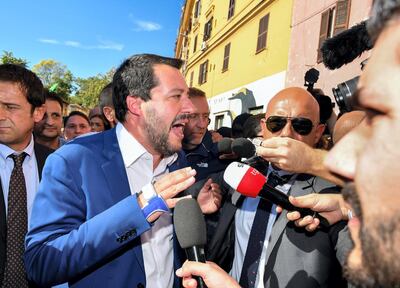When protesters took to the Champs Elysee in mid November, Europe was unaware that what started out as protests against a minor tax in the impending budget might be symptomatic of a wider failing.
As the weekends rolled on, protests spread to a number of French cities — shops and sites across France's tourist hotspots were trashed, and French President Emmanuel Macron was forced to grant major concessions to those taking to the streets.
His election to the French presidency in 2017 was seen by many as an exemplar antidote to the populism sweeping Europe. Mr Macron was the popular, though not populist, personality who successfully staved off both the far right and far left.
In a continent being swamped by populist movements on both the right and left, Mr Macron’s victory was gold dust, and perhaps set a path for others to follow — in Britain, some called for a British Macron, there was even talk of forming parties similar to his En Marche.
That changed in recent months, and as the year drew to a close Europe’s messiah against populism had a something of a revolt on his hands.
If there was a period in 2017 during which mainland Europe might have thought it had dodged the populism that carried Donald Trump into the Oval office and yanked Britain out of the EU, 2018 showed us it is most certainly over.
Britain’s inability to actually agree on what Brexit means, or how it should be carried out has not deterred a host of populist movements, parties and individuals from setting up shop across Europe. Collectively, populists have galvanised huge swathes of national electorates up and down the continent.
In Italy Matteo Salvini's rise to minister of the interior has been fuelled by headline-grabbing anti-immigrant sentiments — labelled fascist by some and hard truths by others. August saw Denmark, regarded by many as a liberal utopia, ban the burqa. In September, a rescue boat carrying 600 migrants was forced into a more than week-long odyssey in search of a place to dock after several countries refused permission, before Spain eventually agreed. Such incidents of abrupt policy decisions propelled by populist rhetoric are now the norm.

Europe's hospitality towards people fleeing conflicts in the Middle East and poverty in Africa has run out, with few exceptions, yet the populist backlash against immigrants appears to growing. Populist parties continue to gain ground, in Germany the AfD humiliated Angela Merkel's coalition, entering the Bavarian state parliament for the first time with 13 per cent of the vote. Eleven European countries now have populist parties in government, up from two some 20 years ago. Europe has yet to find a balance between humanitarian immigration policy and controls sufficient to assure the most vulnerable that immigrants need not be their foe.
Research published by The Guardian last month noted that one quarter of European voters now back a populist party.
_______________
Read more:
Generation Z versus the millennials — coming soon to a street near you
British academic William Davies claims populists have ditched fact for feeling
Where have all the good statesmen and women gone?
World moves in opposite directions on migration
_______________
An aspect that often went unnoticed was that for all the grand narratives of a populist revolt, every European country’s populist movement had a distinctly nationalist and unique flavour to it. Local politicians have become masterful in tailoring their message to the communities they are targeting.
In Hungary, Viktor Orban has evoked memories of the Hungarian-Ottoman wars of the 1500s, Mr Orban would claim he was once again protecting Hungary from a Muslim invasion, in reality he was referring to just a few thousand refugees from Syria passing through on their way to western Europe. He has been relentless in his anti-immigration policies, carrying them out with an increasingly authoritarian edge.
In Sweden, the populism was of a far more contemporary flavour. In 2015, at the height of Europe’s refugee crisis, the country let in more than 160,000 refuges — the most per capita in Europe. Almost across the board, people point to this as a turning point in the country. This year, the anti-immigration Sweden Democrats party increased its share of the vote to 17.6 per cent in September's general election. More crucially, it succeeded in dragging the entirety of political debate to the right. Every party was forced to talk about immigration and crime committed by refugees, which Sweden Democrats' leaders said was a victory in itself. “They are so politically correct; they’ve been afraid to speak about these issues," said Tobias Andersson head of the party's youth wing. "The voters are really tired of it."
In Britain, the dominant theme is anti-EU sentiment. The political union is broken, it is sapping the UK’s sovereignty and treasury, the Brexiteers claim. “Take back control” remains a fixture of political interviews and Westminster speeches.
Donald Trump’s former chief of staff Steve Bannon might like to claim the US president provided the scaffolding for the many forms of European populism that are currently surging in the polls, it would be wrong to give him too much of the credit. The examples of Hungary, Sweden and Britain all demonstrate that a localised narrative is as important as anything else. Copying and pasting the American model that brought the world "Make America Great Again" is not sufficient on its own.
At a conference in Budapest addressed by Mr Bannon, doctoral researcher Annastiina Kallius summed up this point in her response to a question about whether Mr Trump's adviser was launching the alt-right in Hungary.
“Your average Hungarian doesn’t even know the term alt-right," she said. “I’m not even sure how you would translate it into Hungarian”.
Populist movements across Europe have shown that they appeal not only to a disgruntled older population but also to the youth, a demographic that had been considered staunch opponents of populism. Overturning the assumption that young people are more progressive, far-right populist MPs are some of the youngest in parliaments across Europe.
The case of Mr Macron shows that the fight against European populism now resembles a game of whack-a-mole; even in countries where it appears to have been defeated, populism finds a way to return. And that is not to mention the countries and regions in which populist movements broke new ground in 2018.
More than two years on from London’s Brexit vote, there is just one certainty: Europe does not yet have an answer to the rise of populism. Those who claim they do probably cannot see it circling round for another bite.



